
Alessandro Bonvicino, more commonly known as Moretto, or in Italian Il Moretto da Brescia, was an Italian Renaissance painter from Brescia, where he also mostly worked. His dated works span the period from 1524 to 1554, but he was already described as a master in 1516. He was mainly a painter of altarpieces that tend towards sedateness, mostly for churches in and around Brescia, but also in Bergamo, Milan, Verona, and Asola; many remain in the churches they were painted for. The majority of these are on canvas, but a considerable number, including some large pieces, are created on wood panels. There are only a few surviving drawings from the artist.
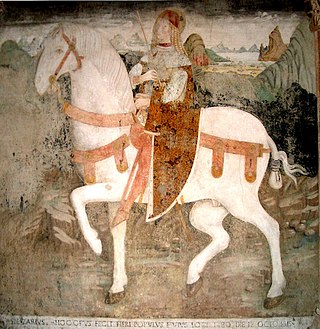
Nazarius and Celsus were two martyrs of whom little is known beyond the discovery of their bodies by Ambrose of Milan.
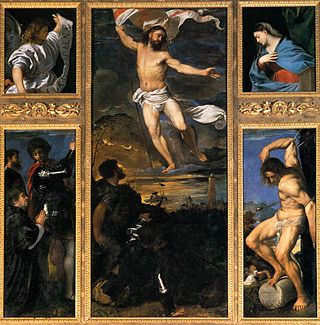
The Averoldi Polyptych, also known as the Averoldi Altarpiece, is a painting by the Italian Renaissance painter Titian, dating to 1520–1522, in the basilica church of Santi Nazaro e Celso in Brescia, northern Italy.
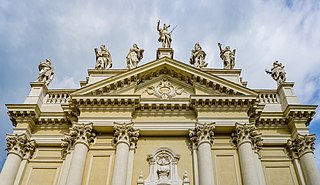
The church of Santi Nazaro e Celso is located on Corso Giacomo Matteotti, at the intersection with via Fratelli Bronzetti, in Brescia, Lombardy, Italy. The church contains the Averoldi Polyptych (1522), a masterwork of Titian.
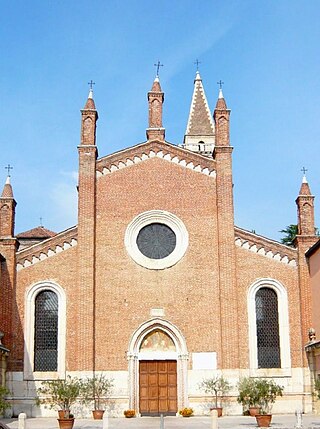
The Church of Saints Nazarius and Celsus is a Catholic place of worship in Verona located in the Veronetta district, on the road leading to Porta Vescovo. Its origin can be traced to around the 7th century when an early, simple monastic building that was built in the Lombard era was erected at the foot of the overlooking Mount Castiglione. Part of this shrine, originally dedicated to St. Michael the Archangel, still survives with its frescoes and mosaic floors. It was probably a martyrion dedicated to the veneration of the relics of Saints Nazarius and Celsus.

The Caprioli Chapel is the second chapel on the left side of the nave of the Church of San Giorgio in Brescia.
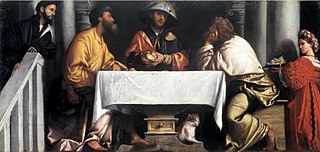
Supper at Emmaus is an oil on canvas painting by Moretto da Brescia, executed c. 1526, now in the Pinacoteca Tosio Martinengo in Brescia. It was originally painted for the Church of San Luca in the city, where it was first recorded in 1630 by Bernardino Faino, who saw it in the San Sebastiano chapel.

Christ and the Angel is an oil on canvas painting by Moretto da Brescia, executed c. 1550, now in the Pinacoteca Tosio Martinengo in Brescia. In 1630 Bernardino Faino recorded it "in the Capella della Santissima Croce d'oro et fiamma" in Brescia's Old Cathedral. It was restored in 1914 and 1935.

Chiesa di San Giovanni Evangelista Organ Case is a set of four tempera on canvas paintings produced by Moretto da Brescia, c. 1535. The inner sides show stories from the life of John the Baptist and scenes from the life of John the Evangelist. They now hang on the walls of the chancel of the church for which they were painted, San Giovanni Evangelista in Brescia.

The Coronation of the Virgin Altarpiece is a five panel work by Moretto da Brescia, executed c. 1534. Its central panel and upper panel are still in the church of Santi Nazaro e Celso in Brescia, whilst the two upper roundels and predella are in the same church's rectory.

Christ with Moses and Solomon is a 1541–1542 oil on canvas painting by Moretto da Brescia, displayed on the altar of the Most Holy Sacrament in the collegiate church of Santi Nazaro e Celso in Brescia, the artist's home town. It has been the altarpiece for that altar throughout the historical record, from Bernardino Faino's mention of it in 1630 to the present day.

Our Lady of Mount Carmel is a painting in oils on canvas by Moretto da Brescia, executed c. 1522 and now in the Gallerie dell'Accademia in Venice. It arrived in the Accademia's collection in exchange for two paintings sent to the Tempio Canoviano in Possagno. The painting is one of the most notable works of the artist's youth. Its original location is unknown as the first confirmed written record of the work dates to the 19th century. It was probably in the Confraternity of Our Lady of Mount Carmel's altar in Santa Maria del Carmine church in Brescia; a reference to a "large canvas ... something of a large study in the hand of Moretto" in Bernardino Faino's 1630 guide to Brescian art may be to this work.

The Sant'Eufemia Altarpiece is a 1526-1530 oil on panel painting by Moretto da Brescia, originally on the high altar of Sant'Afra in Brescia and now in the Pinacoteca Tosio Martinengo in the town. The Sant'Afra Reliquary was also based on the painting. The painting's lower register shows saints Benedict of Nursia, Euphemia, Justina and Paterius.

The Luzzago Altarpiece is a 1542 oil on canvas painting by Moretto da Brescia, now in the Pinacoteca Tosio Martinengo in Brescia. It was recorded in San Giuseppe church in Brescia in 1630 and moved to its present home in 1868. In the lower register Michael the Archangel points the kneeling donor to the Madonna and Child above, whilst Francis of Assisi stands to the right with a cross.
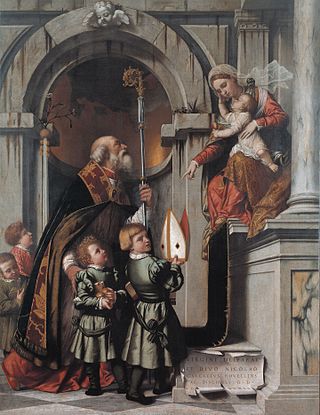
The Rovelli Altarpiece is a 1539 oil on canvas painting by Moretto da Brescia, which since 1899 has been in the Pinacoteca Tosio Martinengo in Brescia, Italy. Strongly influenced by Titian, it is named after the schoolmaster Galeazzo Rovelli who commissioned it for the church of Santa Maria dei Miracoli in Brescia in 1539, where it remained until being removed in the 19th century and replaced by a copy. Its composition was reused by Moroni in his Mystic Marriage of Saint Catherine in the 1560s.

St Anthony of Padua with Two Saints is a c. 1530 oil on canvas painting by Moretto da Brescia, now in the Pinacoteca Tosio Martinengo in Brescia. The other two saints shown are Antony the Great and Nicholas of Tolentino.

St Margaret of Antioch with Two Saints is a 1530 oil on panel painting by Moretto da Brescia on display on the side-altar of St Jerome in the church of San Francesco in Brescia. To the left of Margaret of Antioch is shown Saint Jerome, whilst to the right is Francis of Assisi.
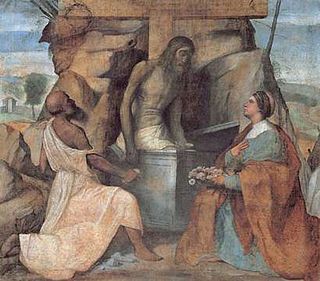
The Dead Christ Adored by Saint Jerome and Saint Dorothy or Saint Jerome and Saint Dorothy Adoring Christ in the Tomb is a 1520-1521 tempera verniciata on canvas painting by Moretto da Brescia. It is on show above the left-hand side door to the church of Santa Maria in Calchera in Brescia, though it is not thought to have originally been produced for that church as neither Jerome nor Dorothy had an active cult in that parish and they rarely appear in art together.
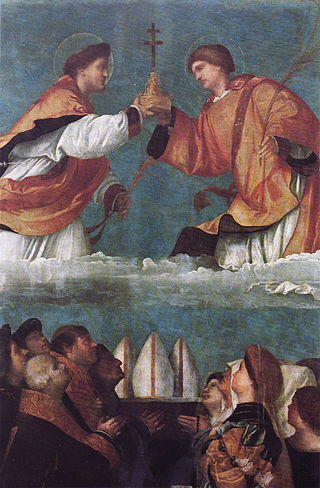
The Holy Cross Standard is a 1520-1521 oil on canvas painting by Moretto da Brescia, commissioned by the Brescia's city council for the Company of the Guardians of the Holy Cross, guardians of the Sante Croci treasury at the city's Old Cathedral. It is now in the Pinacoteca Tosio Martinengo in the city.

Massacre of the Innocents is an altarpiece oil painting by Moretto da Brescia, executed in 1531–1532, originally painted on panel but later transferred to canvas. It is on display on a side altar in San Giovanni Evangelista church in Brescia.




















